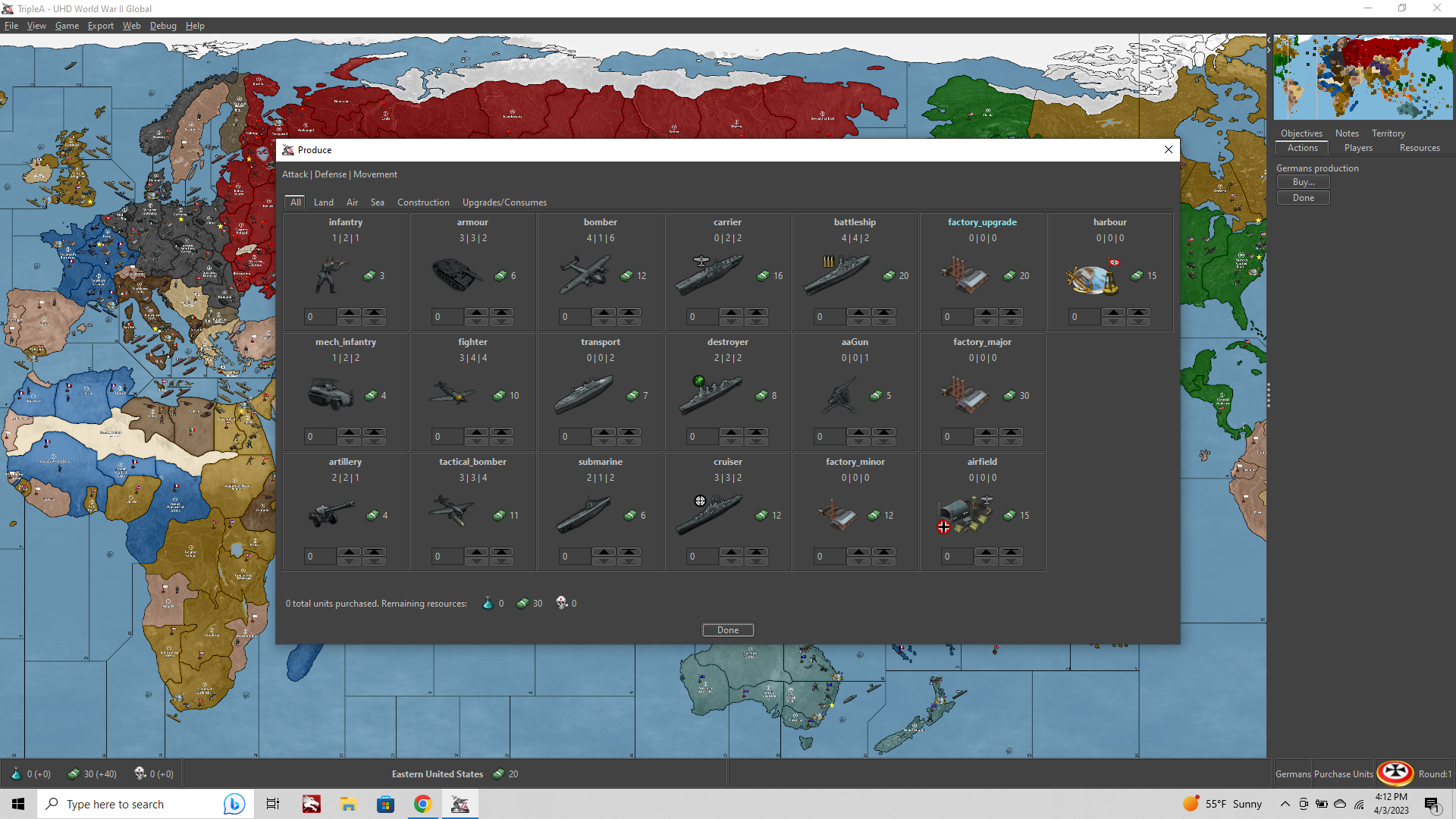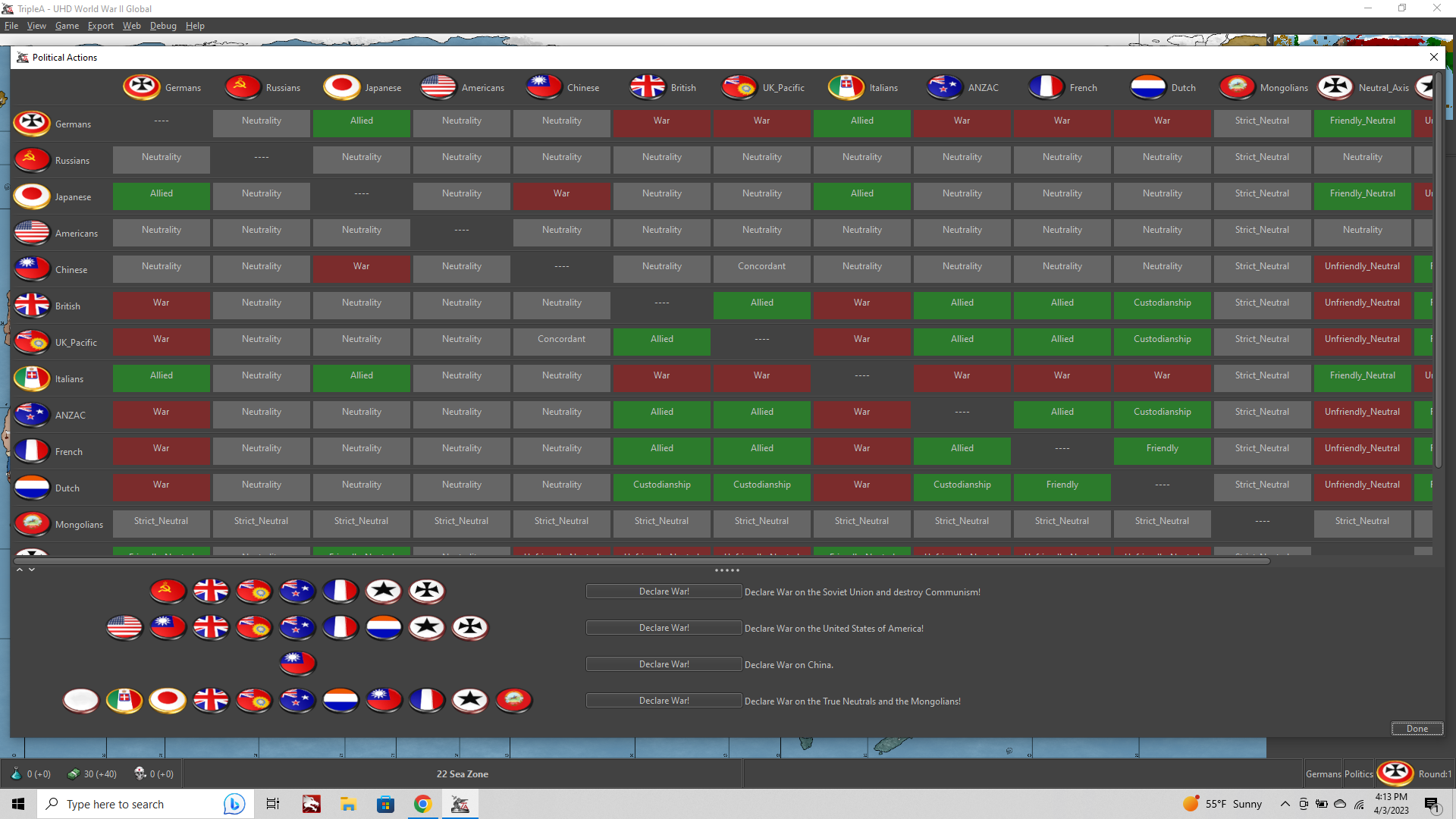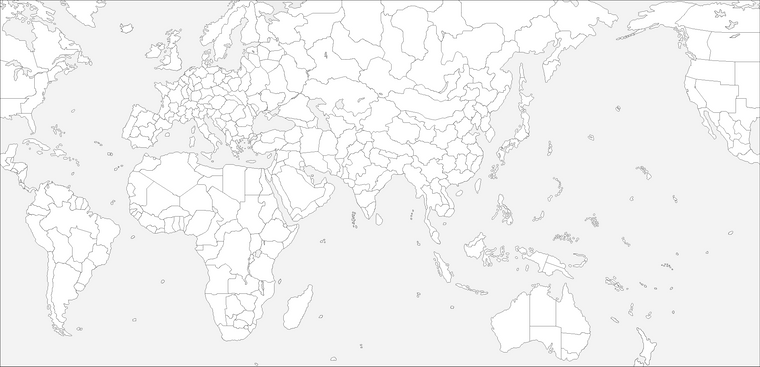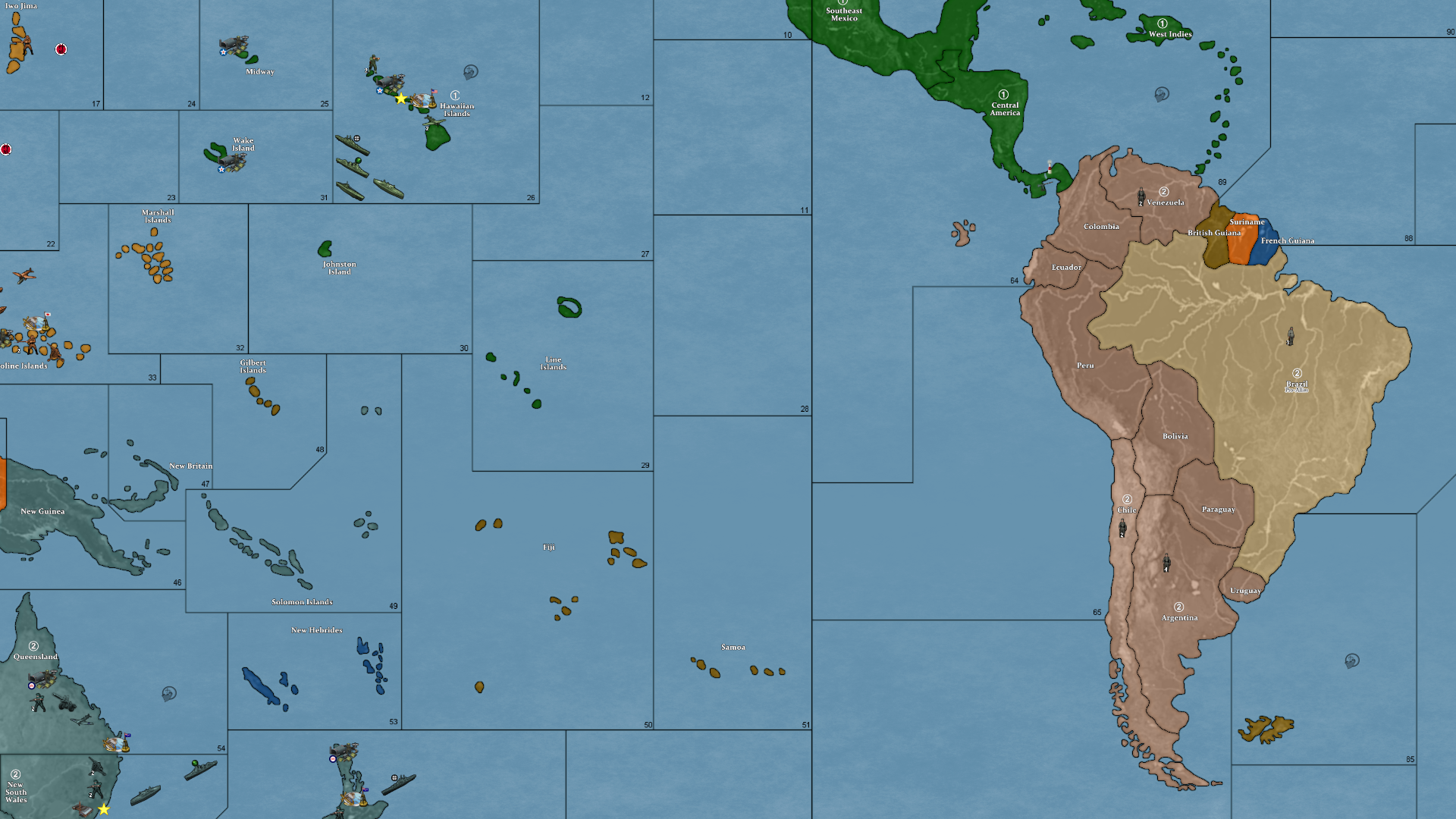So you just bought the Axis and Allies game 1942 second edition, the latest 5 man world theater game… Congratulations, good call! :-D
Perhaps you’re returning to A&A from one of the older games, or maybe this is your first time. Either way, now that you’ve studied the map, got the pieces all laid out, and have finally puzzled your way through the rulebook, its time to dive in and start thinking about the Russian opening! Maybe you’re pre-gaming it, looking to get a match with one of your friends face to face, or are playing WW2 v5 in tripleA vs the HardAI, to get a feel for the map. We’ve all been here at one point, looking at those Russian units and those 24 ipcs and trying to figure out the best way to make use of them. Right about now, you might be thinking to yourself that the Soviet starting position looks kind of ugly, what should you buy? and what is it you’re supposed to do with these Russians units anyway? ha!
Well, here are some ideas about various openings that you might find helpful for the 1942 sec edition game when playing as the Soviets. What follows assumes OOB conditions, (if you know what a bid is and how to play with bids these conditions can be changed), but often times, if you’re starting up a new game with newer players in your group, explaining what a bid is can take more time than its worth, and this is already a fairly involved game. Instead, you, as the more experienced A&A strategist and the one who bought the board, can just let your buddy play Axis while you take the Russians. Sure it’s a challenge, but you’re up to it right! ;)
But what to buy in the first round? This Russian planned economy gives you 24 ipcs out the gate, and this doesn’t allow a whole lot of room for error. Maybe infantry is best? Lets consider it for a moment…
At a cost of 3 ipcs a pop, 24 ipcs gets you 8 infantry, and we know that boots on the ground are always important for the Russians right? I mean just throw more bodies at the problem, that’s one ready solution isn’t it? And surely infantry have the best defensive value for the cost of any unit, and provide the most hitpoints for the least amount of money. Another way to think about it is the total power that your purchased force can project: the cumulative attack value and defense value of the units in the force and how far it can move. We often call these attack or defense ‘points’, or ‘pips’ for the purposes of fast calculation, and try to think about how much attack or defense power the units can bring to bear.
24 ipcs in infantry = 8 hit points, with a total attack value of 8 points, total defense value of 16 points, and it can move 1 space.
In two out of four dimensions, the 8 infantry buy does pretty well. 8 hit points, or hits that you can absorb, in terms of “fodder” with cheap infantry to protect your more expensive attacking/defending units. On defense 16 points, since each individual infantry unit hits at 2 on defense. Taken together, that’s a solid 2 hits on defense reliably, and probably 3 hits or more if the infantry is grouped together and all “dug in.” Rolling a lucky deuce or two, and that kind of infantry stacked together can be quite potent!
But in the other two out of four dimensions, the 8 infantry buy is somewhat lacking. 8 attack points doesn’t sound all that bad at first, but when you start to crunch the numbers, you find that this only gives you a reliable 1 hit, and a “long shot” (1/3 chance) to grab a second hit on attack. And this only when the whole force is attacking at once. Sure there’s always a chance you might roll a bunch of ones, but its not a great chance, and there is of course a chance that you could completely “dud” in your attack. A lucky “one” is just harder to come by than the “lucky deuce” when you’re playing a game with six sided dice. This sort of thinking and logic has given rise to a style of play called “Low Luck” which you may want to familiarize yourself with at some point, just for reference, but similar principles apply in a normal dice game, when you’re trying to figure out what the likely chances are that you’ll get “X number of hits” in a given round of combat. Basically what you’re doing is adding up all the “hits at” values for each unit, the number you end up with shows you how many hits you’re likely to achieve with these units when rolling the six sided dice, by dividing that number by 1/6. This gives you the likely number of hits on average in a dice game, or the auto hits in an LL game, and any remainder left over can likewise give you a sense of how likely it is to pick up an “extra hit.” For a regular dice game these are just rough averages but they’re helpful when thinking about the attack/defense value of the force you’re buying.
Finally there is the aspect that involves movement or range, which for infantry is just 1 space from where they are placed. Now when you look at the map and the production spread for Russia, you’ll see that with an 8 infantry buy, some of these units won’t be able to get into the fight immediately, because the factory in Caucasus can only produce 4 units at a time, and the factory in Karelia is indefensible in the first round, and inf units placed in Moscow will be two moves from the front during the second round. So having surveyed the situation on the ground, for the purposes of attack, buying 8 infantry doesn’t really get you the full 8 attack points the very next round. Instead you end up with just 4 attack points “at the ready”, from the infantry out of Caucasus, and the other 4 infantry units placed in Moscow will take at least one more round to move out “into position.” To defend against German counter attacks in the second round you still get 16 on defense, but from the perspective of an early Russian offensive, the 8 infantry buy nets you just 4 attack points and 4 attack fodder hitpoints “at the ready” in the second round.
Now lets look at some other ways you could spend that same amount of money for different units beyond just “all infantry.” These are all max placement buys, where you spend every ipc with no remainder left over. Listed below with the total hitpoints, total attack points and total defense points for each buy, and finally the number of units with effective range to the front, for immediate counter attack, and the max attack power they can project the following round (during the opening salvo of the combat phase).
Potential Builds:
Buy: 4 infantry and 3 artillery =
Total: 7 hitpoints, 13 attack, 14 defense
Range: 4 units to the front (1 inf, 3 artillery from Caucasus).
Projected Power: +8 counter attack points against Ukraine.
Buy: 6 infantry and 1 tank =
Total: 7 hitpoints, 9 attack, 15 defense
Range: 5 units to the front (4 inf from Caucasus + 1 tank from Moscow).
Projected Power: +7 counter attack points against Ukraine, or + 3 against Karelia/Belo.
Buy: 2 infantry, 3 artillery, and 1 tank=
Total: 6 hitpoints, 13 attack, 13 defense
Range: 5 units to the front (1 inf and 3 art from Caucasus + 1 tank from Moscow).
Projected Power: + 11 counter attack points against Ukraine, or + 3 against Karelia/Belo.
Buy: 6 artillery
Total: 6 hitpoints, 12 attack, 12 defense.
Range: 4 units to the front (4 artillery from Caucasus).
Projected power: +8 counter attack against Ukraine. But this build is sometimes more about the +12 against Caucasus itself, when you plan to give up the factory and then re-take it the next round.
Buy: 4 infantry and 2 tanks =
Total: 6 hitpoints, 10 attack, 15 defense,
Range: 6 units to the front (4 inf from Caucasus +2 tanks from Moscow).
Projected power: + 10 counter attack points against Ukraine, or + 6 against Karelia/Belo.
Buy: 3 artillery and 2 tanks =
Total: 5 hitpoints, 12 attack, 12 defense
Range: 5 units to the front (3 art and 1 tank from Caucasus + 1 tank from Moscow).
Projected power: + 12 counter attack points against Ukraine, or + 6 against Karelia/Belo
Buy: 2 infantry, 2 artillery, 1 fighter
Total: 5 hitpoints, 11 attack, 12 defense
Range 5 units to the front (2 inf and 2 art in Caucasus + 1 fighter in Moscow).
Projected power: +11 counter attack points against Ukraine, or + 3 against Karelia/Belo *extra advantage in light trading of territories/total unit value over time, provided by the third fighter.
Buy: 2 infantry, 3 tanks
Total: 5 hitpoints, 11 attack, 13 defense
Range: 5 units to the front (2 infantry and 2 tanks in Caucasus + 1 tank in Moscow).
Projected power: +11 counter attack points against Ukraine, or + 9 against Karelia/Belo.
Now that’s a lot of numbers I’ve thrown around, but when you see them all laid out, you’ll notice that when you opt to buy more expensive units, what you’re doing is trading Russian hit points and defense points, for Russian attack points and a greater effective range on counter attack. There is some flexibility here and a little room to pick and choose, depending on how aggressive you want to be with the Soviets, but there is a point at which it’s simply no longer worth it to exchange hit points/defense, for power projection on counter attack. I would suggest that if you go lower than 5 hit points in the opening round purchase with Russia, its likely that you will lose control of Moscow to the Axis during the endgame (if your opponent is fairly competent.) Even 5 hit points is rather low, and what I would consider a “gambit,” meaning that you’re counting on a fairly lucky roll with your Russian openings and counter attacks to make up the difference on hitpoints by killing German units and just losing a couple pawns.
A 6 hitpoint purchase will allow you to project some power with counter attacks in the second round, without giving up too much defense later on. This is what I would consider an aggressive Russian purchase, meaning that you will have a decent offensive capacity if the rolls go your way, but still retain an alright defensive capacity if the rolls go poorly. The 6 hitpoint purchases are all about threatening counter attacks against an early German stack in Karelia or Belo. Trying to buy yourself one more round of trading territories, before you have give them up to the Germans.
A 7 or 8 hitpoint purchase is what I would consider fairly conservative, meaning that you plan to play a primarily defensive game with the Russians, giving up ground early in exchange for a slightly better defense later on, and relying heavily on the Western Allies to make up the difference for you.
Why does all this matter? You might rightly ask.
Well basically, because what you buy with Russia will determine how many attacks you can realistically run in the first round, with decent odds of success, and how quickly your friends the Anglo-Americans will have to send you assistance to prevent your capital from being captured by the Axis.
–--------
Now that we’ve thought about purchases for a minute, lets look at the Russian production spread, and see how the starting factories factor into things.
Karelia: Forget about it! :-D There’s just no way you’re going to keep the Germans from taking this territory in the first round. Seriously, its a lost cause. Even if you took Belo and Baltic states, even if you somehow managed to sink the German transport in sz5 with a risky double fighter attack, even if you took W. Russia light, and then blitzed all your tanks to Lengingrad on Non Combat, even if you bought 2 fighters and placed them in Karelia… its just not going to happen. Sadly the Germans will still have you beat, and the Total Unit Value (TUV) trade is terrible, not to mention costing you the whole Eastern front in the process. So just resolve in your mind right now, that Karelia is toast for the time being. Eventually you might be able to liberate it, but holding this factory at the outset is hopeless. The best you can do is trade the territory back and forth for a couple rounds, and keep the Germans from using your own factory against you! And that’s the real key, because what you’d really like to avoid here, is Germany stacking the territory on the first round. In addition to all the German units in the neighborhood, the Japanese can even reach Karelia with their Tokyo Bomber (6 moves) to put an extra defensive pip on the territory. That’s a lot of Axis units for the Russians to overcome!
It means that you either need enough units of your own stacked against it, or you have to shave off some of those German units in your opening attacks to prevent them from going north. The latter option is particularly risky, since its hard to predict how many hits the German defender might put up in W. Russia itself, let alone Belo, or Baltic States. There’s also Caucasus, that other all important factory territory you have to consider in your opening…
Caucasus: Don’t forget about it! :-D
Now that Karelia is off the table, and you’re firmly resolved to just grin and bear the loss of that northern factory for a while, its time to look at that other factory down south! Caucasus is arguably the most important Russian territory after Moscow and W. Russia, not because you need the production per se, but because its very important to deny this production to the Axis. Letting the Axis gain control of a factory that boarders your Capital is just an all around nightmare for the Allied war effort, so you should do everything you can to avoid this for as long as possible. Fortunately, unlike Karelia, it is possible to defend Caucasus in the first round. Its also possible to trade this territory and recover it quickly, owing to the fact that the British are in the area and can lend a hand with their tanks/fighters if need be, but its still a good idea to keep Caucasus under your thumb. Even if you can’t hold it forever, you at least want to threaten it on counter attack with enough force to prevent the Germans from stacking there and then flying in Japanese fighter cover. Once that happens, it becomes very hard to control the center of the gamemap and your Russians will be more or less pigeon holed into an entirely defensive “turtle up” posture. This is something you might be able to manage during the endgame, once the Western Allies have some units nearby to help prop you up, but its a disaster to let happen in early rounds. Caucasus is the main objective of most Axis drives early on, and what they will try to do is force you out of this territory (often by making you choose between Caucasus and the Capital Moscow.) For your part, you’ll want to push this decision out as far as possible. The best way you can do this is to either stack Caucasus itself, or stack W. Russia and Moscow with enough troops, that any German units that move into Caucasus will be immediately destroyed the following round on counter.
Finally, Moscow: the Center must hold! :-D
Losing Moscow early on, is basically losing the whole game. During the endgame it is possible to trade Moscow for an Axis capital, but in order to even get to the point where something like that is possible, you need to hold Moscow for a pretty long time. Lets put it this way, if you give the Axis a shot on the Russian capital anytime before round 7, things are probably going to end badly for Allies. So what does this mean? Well basically it means keeping Axis units more than 1 move away from Moscow, while at the same time keeping Allied units close enough that they can reach Moscow in 1 move if they have to. And frequently, it means sending US/UK units (esp. aircraft, but also ground) into Russian territories to ensure this.
OK, that was all background and a fairly long winded way to arrive at…
All the Russian Openings!
The rest of this thread below will be for descriptions of specific Russian openings, from basic/general stuff to the more complex, and I invite anyone else here who has thoughts on the subject to post those here as well. TripleA saves would be nice if you want to share examples. I’ll start us off with one of the more popular…



















